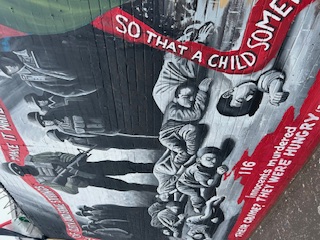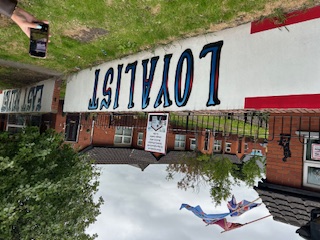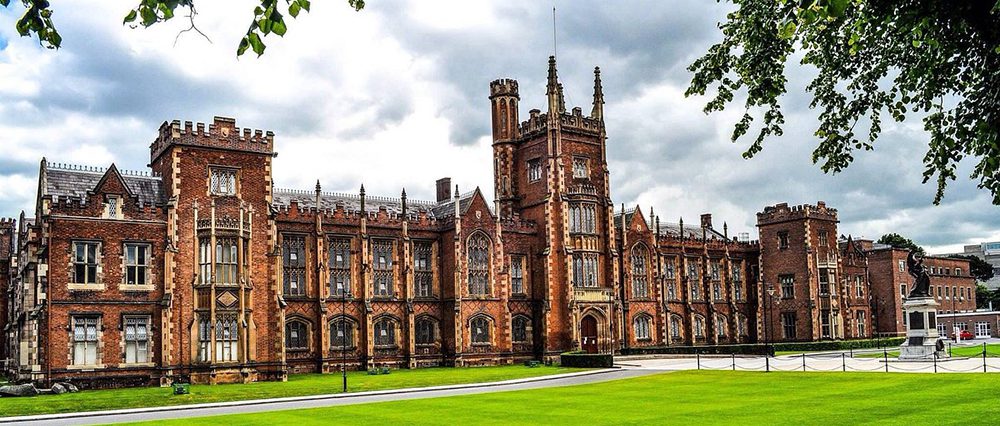Today was the first day of organized classes at the Queens University of Belfast. To start the day off, my cohort and every other cohort met in the morning at the main area of BT9, the cohorts were from UMass Lowell and from other colleges from America and even from other countries. Once we were all gathered, we left as a giant group to head to the school. We all gathered in the Bell lecture theater. We were introduced to all the staff that would be teaching us over the next couple of days. The organizers of the event made around fifteen groups, and made groups of people from different cohorts, to get us to meet some people outside of our cohorts. I was in group fourteen.
In these groups we took four quizzes consisting of ten questions about Irish culture. The first quiz was about general Irish culture, the second question was about identifying Irish pop culture icons, the third quiz was about identifying flags, and the fourth quiz was about Irish history. Of the three quizzes my group was able to score nine and a half out of forty points. After the quizzes were over, we were told a general overview of the day and what was to come in the week. We took a thirty-minute break and returned to the lecture hall. We were placed into larger groups and were then taken on a tour of the school. We were shown various areas of the school like the courtyards, the law school and the different parts of the student union. I was glad to see more of the school because the campus is so old and has such interesting architecture to look at.

After the tour was over everyone went to lunch. I went with some friends to a wing place called wing it. I got the mac and cheese fries; they were very good. We then got on a bus to take a bus tour of Belfast. The bus tour went great. It started off with the bus driving through different neighborhoods of Belfast. It was quite jarring to see the differences between neighborhoods, especially in the more working-class neighborhoods. If the neighborhood was poorer the more, they showed their political and cultural affiliations. In some parts of Belfast almost every other block was catholic or protestant in every working-class neighborhood there was at least one Mural that was dedicated to their respective sides, it appears that they would go all out with language used and images portrayed.
After some driving around we came to our first stop. The first stop was the peace wall. The peace wall is found in west Belfast. The peace wall is covered in murals. When you are there, it feels as though the wall could go on forever. The wall is covered in these beautiful murals that are painted on the wall from the very bottom of the wall to the very top of the wall. They are not all painted on. Some of them are giant plastic screens that have images and messages printed on them. The messages on the wall were usually political. A large chunk of the wall was dedicated to the crisis in Gaza between Israel and Palestine. Many of the murals even shoved imagery of Palestinians and Irish people holding hands. Some of them show the Palestinians and Irish people going through similar situations. There was a poem that was written along the wall on a red ribbon. That went down much of the wall. A lot of the wall was also commemorating Irish figures that supported Irish republicanism. What was most jarring about the wall was when we went over to the unionist side. We only got to see a small portion of the other side. What we saw was the commemoration of figures and groups that wanted to keep Northern Ireland British. They were also murals that were dedicated to the Israeli state and its soldiers. It was interesting to see how the different neighborhoods oriented themselves with the conflict.


We then went to a different section of the peace wall that had a memorial on it. The memorial was dedicated to peace, a rule was put in place not to draw on the wall, it was covered in graffiti and peoples’ names. We then were brought to one Protistan working class neighborhood. The neighborhood was covered in murals and memorials that were dedicated to different groups and people that fought to keep Northern Ireland British. We were then brought to a working-class catholic neighborhood, The neighborhood had murals and memorials that were dedicated to the people who fought for Northern Ireland to be separate from Northern Ireland. It is still so interesting to see how different both sides of the conflict, that was supposedly resolved decades ago, are from each other. Today was a day that was full of sights to see and things to learn. I feel that today was a great way to set the group up for what is to come on the following days of the week.


